Page 522 of 648
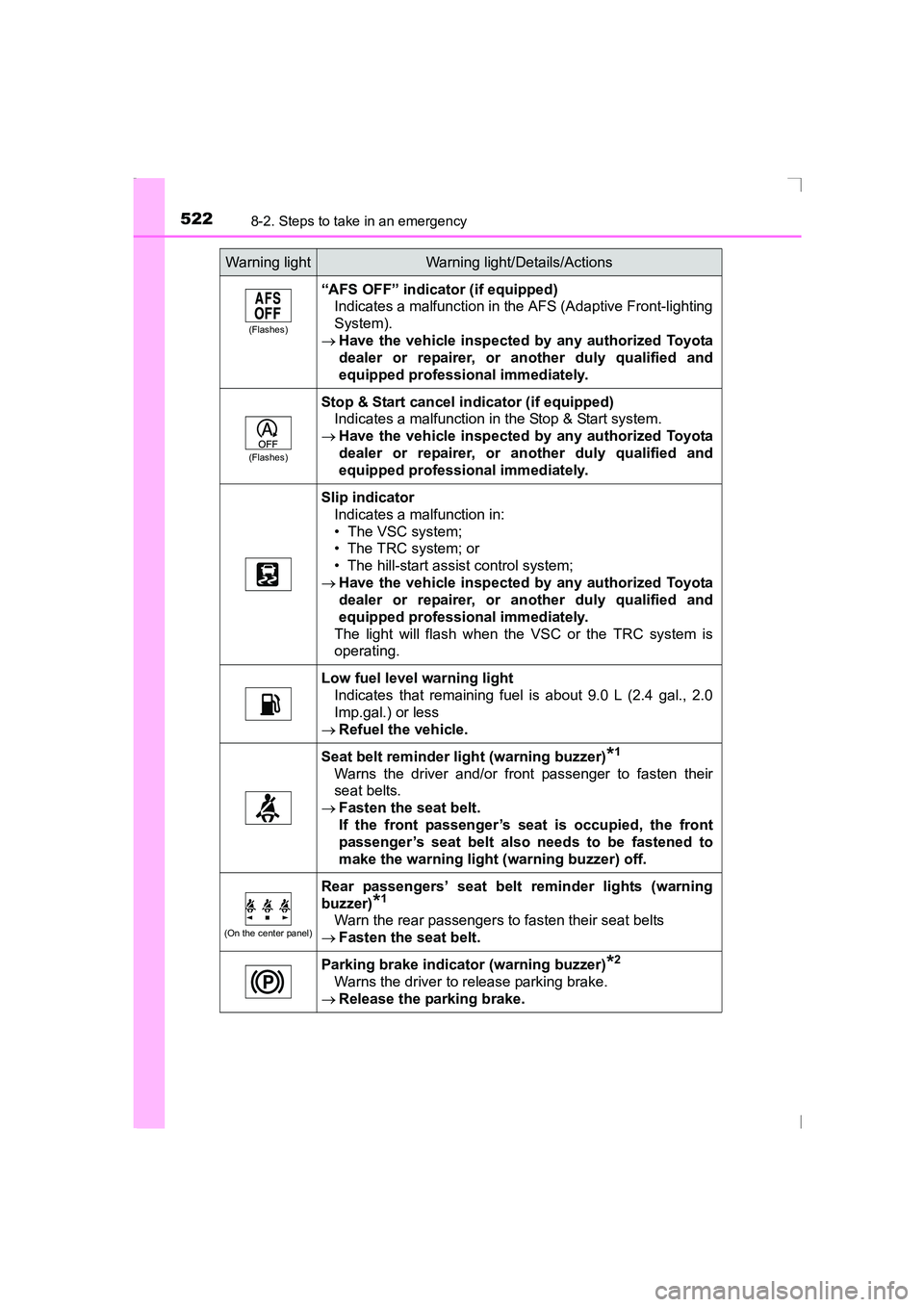
5228-2. Steps to take in an emergency
AVENSIS_OM_OM20C20E_(EE)
(Flashes)
“AFS OFF” indicator (if equipped)Indicates a malfunction in the AFS (Adaptive Front-lighting
System).
→ Have the vehicle inspected by any authorized Toyota
dealer or repairer, or another duly qualified and
equipped professional immediately.
(Flashes)
Stop & Start cancel indicator (if equipped) Indicates a malfunction in the Stop & Start system.
→ Have the vehicle inspected by any authorized Toyota
dealer or repairer, or another duly qualified and
equipped professional immediately.
Slip indicator Indicates a malfunction in:
• The VSC system;
• The TRC system; or
• The hill-start assist control system;
→ Have the vehicle inspected by any authorized Toyota
dealer or repairer, or another duly qualified and
equipped professional immediately.
The light will flash when the VSC or the TRC system is
operating.
Low fuel level warning light Indicates that remaining fuel is about 9.0 L (2.4 gal., 2.0
Imp.gal.) or less
→ Refuel the vehicle.
Seat belt reminder light (warning buzzer)*1
Warns the driver and/or front passenger to fasten their
seat belts.
→ Fasten the seat belt.
If the front passenger’s seat is occupied, the front
passenger’s seat belt also needs to be fastened to
make the warning light (warning buzzer) off.
(On the center panel)
Rear passengers’ seat belt reminder lights (warning
buzzer)
*1
Warn the rear passengers to fasten their seat belts
→ Fasten the seat belt.
Parking brake indicator (warning buzzer)*2
Warns the driver to release parking brake.
→ Release the parking brake.
Warning lightWarning light/Details/Actions
AVENSIS_OM_OM20C20E_(EE).book Page 522 Thursday, January 29, 2015 1:47 PM
Page 535 of 648
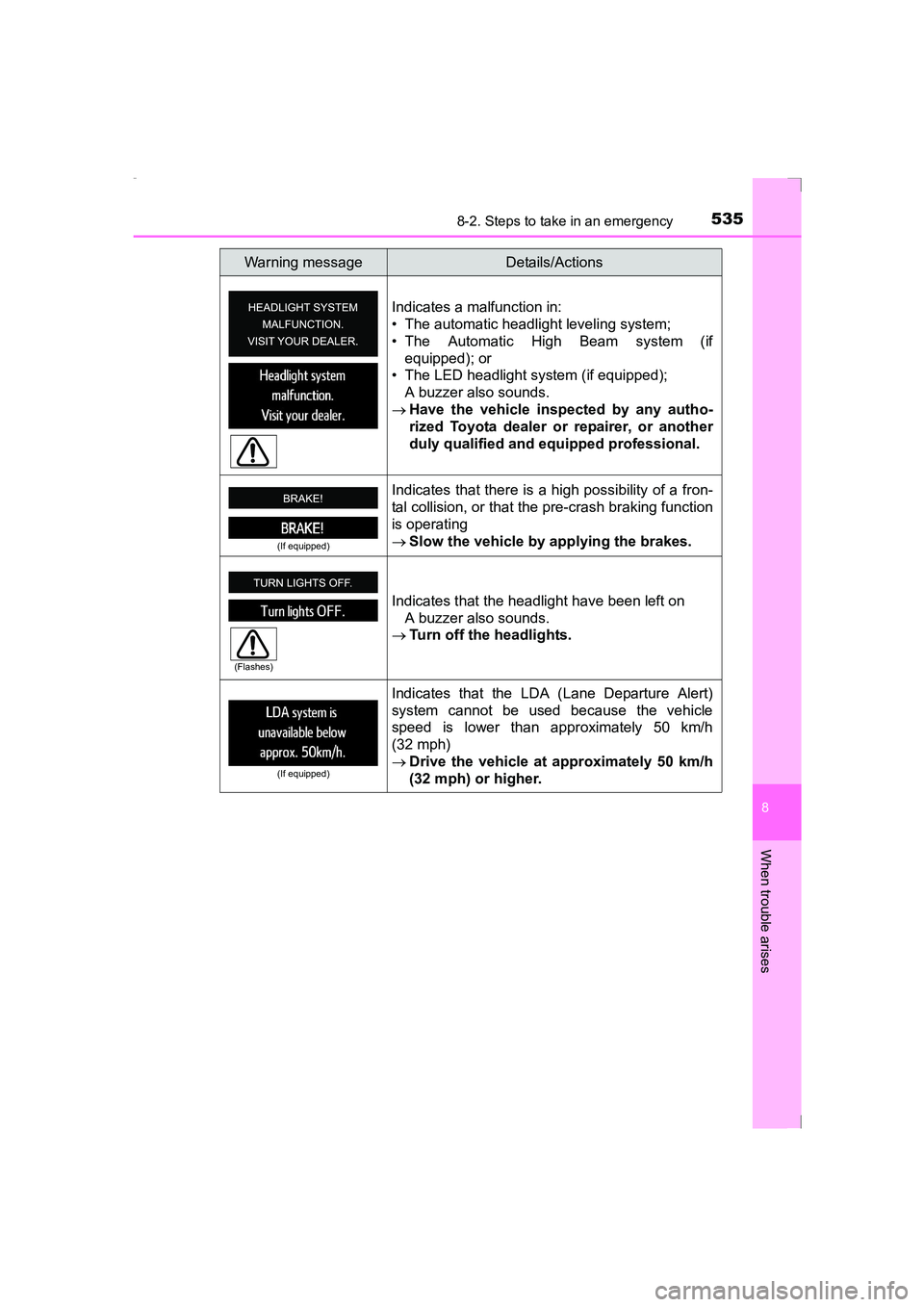
5358-2. Steps to take in an emergency
AVENSIS_OM_OM20C20E_(EE)
8
When trouble arises
Indicates a malfunction in:
• The automatic headlight leveling system;
• The Automatic High Beam system (ifequipped); or
• The LED headlight system (if equipped);
A buzzer also sounds.
→ Have the vehicle inspected by any autho-
rized Toyota dealer or repairer, or another
duly qualified and equipped professional.
(If equipped)
Indicates that there is a high possibility of a fron-
tal collision, or that the pre-crash braking function
is operating
→Slow the vehicle by applying the brakes.
Indicates that the headlight have been left on A buzzer also sounds.
→ Turn off the headlights.
(If equipped)
Indicates that the LDA (Lane Departure Alert)
system cannot be used because the vehicle
speed is lower than approximately 50 km/h
(32 mph)
→Drive the vehicle at approximately 50 km/h
(32 mph) or higher.
Warning messageDetails/Actions
(Flashes)
AVENSIS_OM_OM20C20E_(EE).book Page 535 Thursday, January 29, 2015 1:47 PM
Page 575 of 648
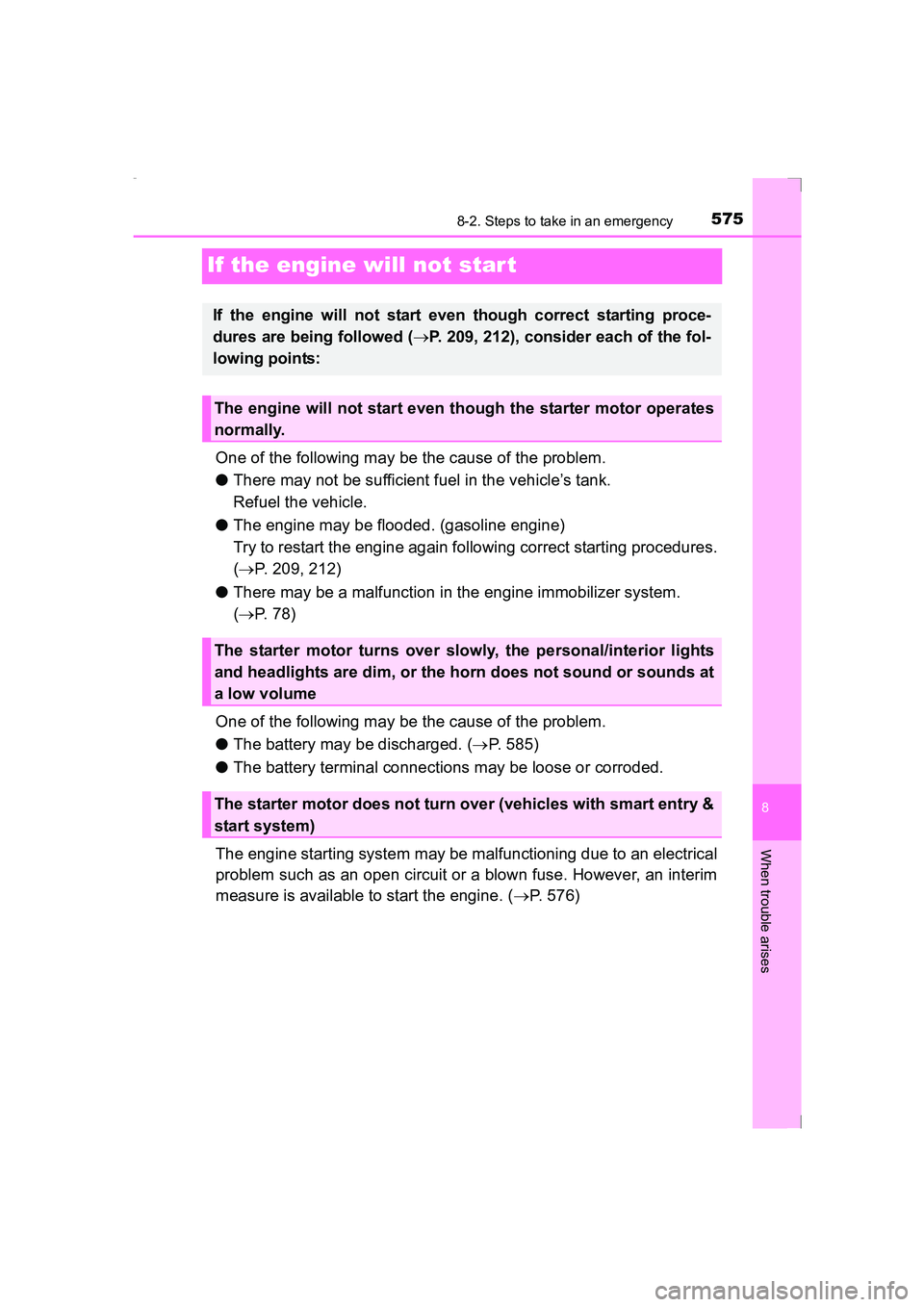
5758-2. Steps to take in an emergency
AVENSIS_OM_OM20C20E_(EE)
8
When trouble arises
If the engine will not star t
One of the following may be the cause of the problem.
●There may not be sufficient fuel in the vehicle’s tank.
Refuel the vehicle.
● The engine may be flooded. (gasoline engine)
Try to restart the engine again following correct starting procedures.
(→ P. 209, 212)
● There may be a malfunction in the engine immobilizer system.
(→ P. 7 8 )
One of the following may be the cause of the problem.
● The battery may be discharged. ( →P. 585)
● The battery terminal connections may be loose or corroded.
The engine starting system may be malfunctioning due to an electrical
problem such as an open circuit or a blown fuse. However, an interim
measure is available to start the engine. ( →P. 576)
If the engine will not start even though correct starting proce-
dures are being followed ( →P. 209, 212), consider each of the fol-
lowing points:
The engine will not start even though the starter motor operates
normally.
The starter motor turns over slowly, the personal/interior lights
and headlights are dim, or the horn does not sound or sounds at
a low volume
The starter motor does not turn over (vehicles with smart entry &
start system)
AVENSIS_OM_OM20C20E_(EE).book Page 575 Thursday, January 29, 2015 1:47 PM
Page 576 of 648
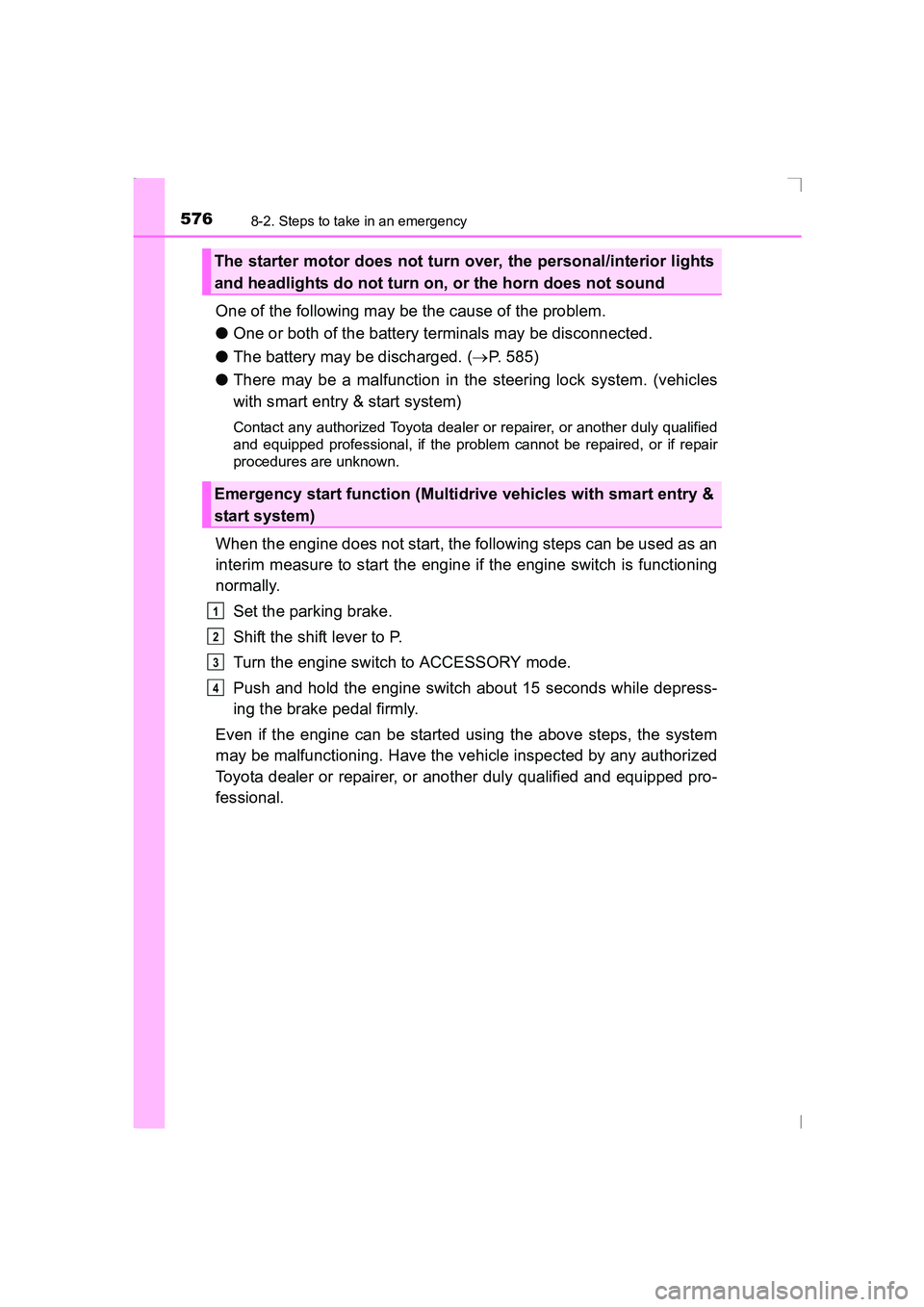
5768-2. Steps to take in an emergency
AVENSIS_OM_OM20C20E_(EE)
One of the following may be the cause of the problem.
●One or both of the battery terminals may be disconnected.
● The battery may be discharged. ( →P. 585)
● There may be a malfunction in the steering lock system. (vehicles
with smart entry & start system)
Contact any authorized Toyota dealer or repairer, or another duly qualified
and equipped professional, if the problem cannot be repaired, or if repair
procedures are unknown.
When the engine does not start, the following steps can be used as an
interim measure to start the engine if the engine switch is functioning
normally.
Set the parking brake.
Shift the shift lever to P.
Turn the engine switch to ACCESSORY mode.
Push and hold the engine switch about 15 seconds while depress-
ing the brake pedal firmly.
Even if the engine can be started using the above steps, the system
may be malfunctioning. Have the vehicle inspected by any authorized
Toyota dealer or repairer, or another duly qualified and equipped pro-
fessional.
The starter motor does not turn over, the personal/interior lights
and headlights do not turn on, or the horn does not sound
Emergency start function (Multidrive vehicles with smart entry &
start system)
1
2
3
4
AVENSIS_OM_OM20C20E_(EE).book Page 576 Thursday, January 29, 2015 1:47 PM
Page 587 of 648
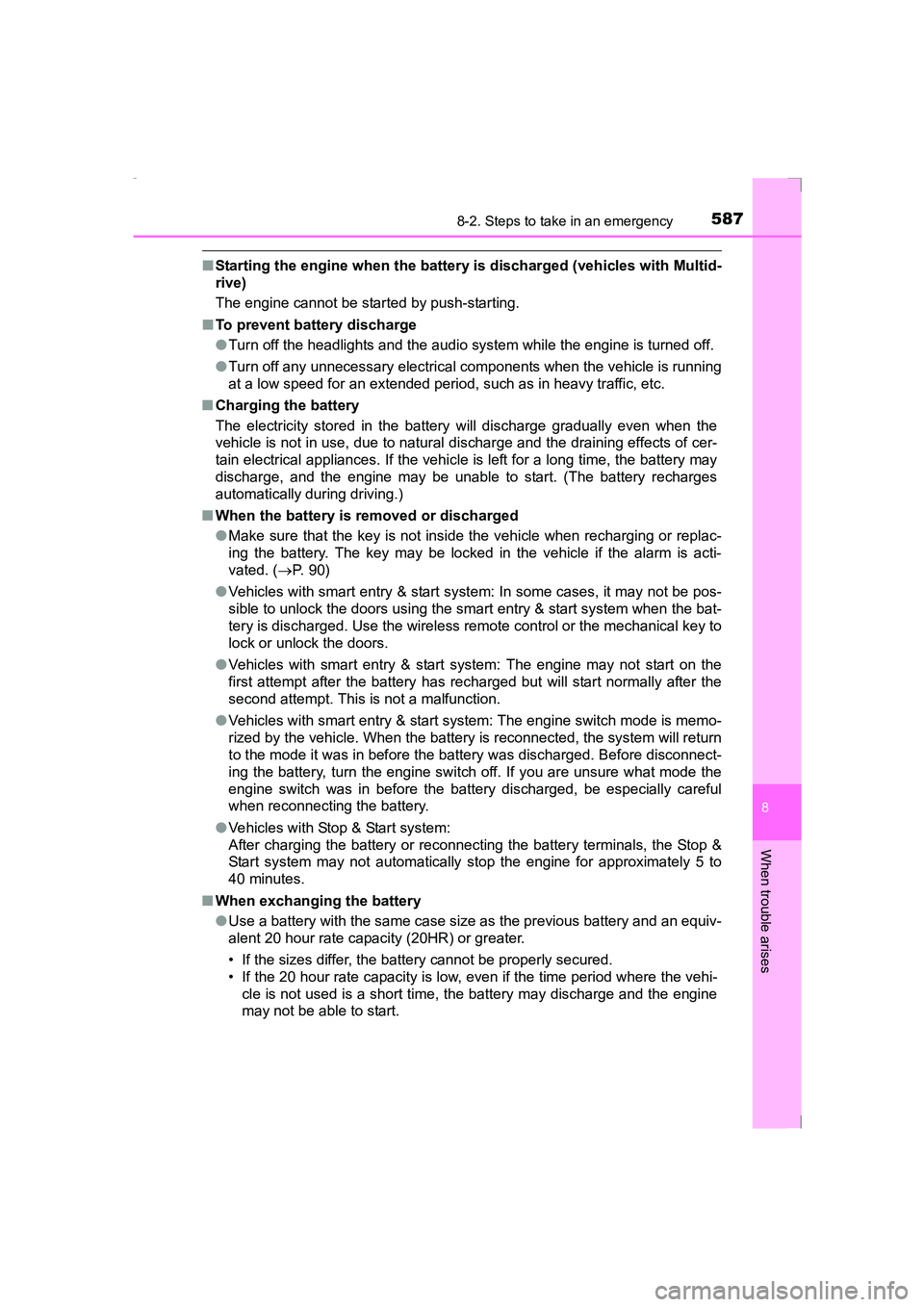
5878-2. Steps to take in an emergency
AVENSIS_OM_OM20C20E_(EE)
8
When trouble arises
■Starting the engine when the battery is discharged (vehicles with Multid-
rive)
The engine cannot be started by push-starting.
■ To prevent battery discharge
●Turn off the headlights and the audio system while the engine is turned off.
● Turn off any unnecessary electrical components when the vehicle is running
at a low speed for an extended period, such as in heavy traffic, etc.
■ Charging the battery
The electricity stored in the battery will discharge gradually even when the
vehicle is not in use, due to natural discharge and the draining effects of cer-
tain electrical appliances. If the vehicle is left for a long time, the battery may
discharge, and the engine may be unable to start. (The battery recharges
automatically during driving.)
■ When the battery is removed or discharged
●Make sure that the key is not inside the vehicle when recharging or replac-
ing the battery. The key may be locked in the vehicle if the alarm is acti-
vated. ( →P. 90)
● Vehicles with smart entry & start system: In some cases, it may not be pos-
sible to unlock the doors using the smart entry & start system when the bat-
tery is discharged. Use the wireless remote control or the mechanical key to
lock or unlock the doors.
● Vehicles with smart entry & start system: The engine may not start on the
first attempt after the battery has recharged but will start normally after the
second attempt. This is not a malfunction.
● Vehicles with smart entry & start system: The engine switch mode is memo-
rized by the vehicle. When the battery is reconnected, the system will return
to the mode it was in before the battery was discharged. Before disconnect-
ing the battery, turn the engine switch off. If you are unsure what mode the
engine switch was in before the battery discharged, be especially careful
when reconnecting the battery.
● Vehicles with Stop & Start system:
After charging the battery or reconnecting the battery terminals, the Stop &
Start system may not automatically stop the engine for approximately 5 to
40 minutes.
■ When exchanging the battery
●Use a battery with the same case size as the previous battery and an equiv-
alent 20 hour rate capacity (20HR) or greater.
• If the sizes differ, the battery cannot be properly secured.
• If the 20 hour rate capacity is low, even if the time period where the vehi-
cle is not used is a short time, the battery may discharge and the engine
may not be able to start.
AVENSIS_OM_OM20C20E_(EE).book Page 587 Thursday, January 29, 2015 1:47 PM
Page 610 of 648
6109-1. Specifications
AVENSIS_OM_OM20C20E_(EE)
The fluid capacity is the quantity of reference. If replacement is neces-
sary, contact any authorized Toyota dealer or repairer, or another duly
qualified and equipped professional.
Electrical system
Battery
Open voltage at 20°C (68 °F): 12.6 12.8 V Fully charged
12.2 12.4 V Half charged
11 . 8 12.0 V Discharged
(Voltage is checked 20 minutes after
the engine and all the lights are
turned off.)
Charging rates 5 A max.
Multidrive
Fluid capacity
(reference)2ZR-FAE engine7.5 L (7.9 qt., 6.6 Imp.qt.)
3ZR-FAE engine7.2 L (7.6 qt., 6.3 Imp.qt.)
Fluid typeToyota Genuine CVT Fluid FE
NOTICE
■ Multidrive fluid type
Using transmission fluid other than “Toyota Genuine CVT Fluid FE” may
cause deterioration in shift quality, locking up of your transmission accom-
panied by vibration, and ultimately dam age the transmission of your vehicle.
sec_09-01.fm Page 610 Friday, February 20, 2015 3:48 PM
Page 615 of 648
6159-1. Specifications
AVENSIS_OM_OM20C20E_(EE)
9
Vehicle specifications
�XCompact spare tire
Tire size T145/70D17 106M
Tire inflation pressure
(Recommended cold tire
inflation pressure)420 kPa (4.2 kgf/cm2 or bar, 60 psi)
Wheel size 17
× 4T
Wheel nut torque 103 N•m (10.5 kgf•m, 76 ft•lbf)
Light bulbs
Light bulbsWTyp e
Exterior Headlights (halogen bulbs) 55 A
Front turn signal lights 21 B
Front fog lights 19 C
Cornering/fog lights 55 D
Side turn signal lights 5 B
Rear turn signal lights 21 E
Back-up lights 16 F
License plate lights 5 F
Interior
Personal/interior lights 8 F
Vanity lights 8 F
Door courtesy lights 5 G
Trunk/luggage compartment light 5 G
A: HIR2 halogen bulbs
B: Wedge base bulbs (amber)
C: H16 halogen bulbs
D: H11 halogen bulbs E: Single end bulbs (clear)
F: Wedge base bulbs (clear)
G: Double end bulbs
AVENSIS_OM_OM20C20E_(EE).book Page 615 Thursday, January 29, 2015 1:47 PM
Page 626 of 648
6269-2. Customization
AVENSIS_OM_OM20C20E_(EE)■
Automatic light control system (
→P. 232)
*: If equipped
■
Illumination ( →P. 399)
*: Vehicles with smart entry & start system
FunctionDefault
settingCustomized setting
Light sensor sensitivityLevel 3Level 1 to 5O-O
Follow me home*
(Time elapsed before head-
lights automatically turn off)30
seconds
60
seconds
--
O90
seconds
120
seconds
123
FunctionDefault settingCustomized setting
Time period before lights turn
off 15 seconds7.5 seconds
O-O
30 seconds
Operation after the engine
switch is turned to the
“LOCK” position (vehicles
without smart entry & start
system) or off (vehicles with
smart entry & start system)
ONOFF - - O
Operation when the doors
are unlocked ON OFF - - O
Operation when you
approach the vehicle with the
electronic key on your person
(When the interior light
switch is in the door posi-
tion)
*
ONOFF - - O
Foot lightsONOFF - - O
123
AVENSIS_OM_OM20C20E_(EE).book Page 626 Thursday, January 29,
2015 1:47 PM